On the Behavior of Honeycomb, Grid and Triangular PLA Structures under Symmetric and Asymmetric Bending
Abstract
1. Introduction
- -
- Infill geometries defined by a 2D model, identical for two successive layers (the result is a 2.5D structure with prismatic cells oriented along the Z axis of the printer);
- -
- -
- Lattice-type infill geometries [8];
- -
- -
- Infill geometries with variable structure resulting from topological optimization.
2. Materials and Methods
- (a)
- The analysis of the three-point bending behavior (symmetric bending);
- (b)
- The analysis of the asymmetric bending behavior for cantilever beam loaded by a force disposed inclined to the main axes of inertia Y and Z.
3. Results and Discussion
3.1. Three-Point Bending
3.2. The Variation of Resultant Displacement in Unsymmetrical Bending
4. Conclusions
- -
- The grid cell structure has significantly larger displacements than the hexagonal cell structure at the same material consumption.
- -
- At the same material consumption, the triangular cell structure has slightly smaller displacements than the hexagonal cell structure.
- -
- For hexagonal/triangular cell structures the displacements do not vary significantly with the orientation of the force relative to the principal axes of inertia. These types of structure are suitable for mechanical components where the force changes direction in the YZ plane.
- -
- For the grid structure the variation of displacements with the orientation of the force relative to the principal axes of inertia is large; displacements are higher when the force acts perpendicular to the axis of the prismatic cells of the grid geometry.
Author Contributions
Funding
Data Availability Statement
Conflicts of Interest
References
- Goh, G.D.; Yap, Y.L.; Tan, H.K.J.; Sing, S.L.; Goh, G.L.; Yeong, W.Y. Process–Structure–Properties in Polymer Additive Manufacturing via Material Extrusion: A Review. Crit. Rev. Solid State Mater. Sci. 2019, 45, 113–133. [Google Scholar] [CrossRef]
- Liu, J.; Gaynor, A.T.; Chen, S.; Kang, Z.; Suresh, K.; Takezawa, A.; Li, L.; Kato, J.; Tang, J.; Wang, C.C.L.; et al. Current and Future Trends in Topology Optimization for Additive Manufacturing. Struct. Multidiscip. Optim. 2018, 57, 2457–2483. [Google Scholar] [CrossRef]
- Bergonzi, L.; Vettori, M.; Stefanini, L.; D’Alcamo, L. Different Infill Geometry Influence on Mechanical Properties of FDM Produced PLA. IOP Conf. Ser. Mater. Sci. Eng. 2021, 1038, 012071. [Google Scholar] [CrossRef]
- Kaidouchi, H.; Kebdani, S.; Slimane, S.A. Vibro-Acoustic Analysis of the Sound Transmission through Aerospace Composite Structures. Mech. Adv. Mater. Struct. 2022, 29, 1–11. [Google Scholar] [CrossRef]
- Qamar Tanveer, M.; Mishra, G.; Mishra, S.; Sharma, R. Effect of Infill Pattern and Infill Density on Mechanical Behaviour of FDM 3D Printed Parts—A Current Review. Mater. Today Proc. 2022, 62, 100–108. [Google Scholar] [CrossRef]
- Ma, R.; Li, M.; Xu, Y.; Meloni, M.; Feng, J.; Cai, J. Geometry Design and In-Plane Compression Performance of Novel Origami Honeycomb Material. Thin-Walled Struct. 2022, 181, 110111. [Google Scholar] [CrossRef]
- Zhang, K.; Xie, X.; Wang, C.; Wang, H.; Xu, F.; Wang, H.; Zhang, X.; Guan, H.; Qu, H.; Zhang, J. Optomechanical Performances of Advanced Lightweight Mirrors Based on Additive Manufacturing. Micromachines 2022, 13, 1334. [Google Scholar] [CrossRef]
- Qin, D.; Sang, L.; Zhang, Z.; Lai, S.; Zhao, Y. Compression Performance and Deformation Behavior of 3D-Printed PLA-Based Lattice Structures. Polymers 2022, 14, 1062. [Google Scholar] [CrossRef]
- Kim, S.; Andreu, A.; Kim, I.; Kim, J.-H.; Lee, J.; Yoon, Y.-J. Continuously Varied Infill Pattern (ConVIP): Improvement of Mechanical Properties and Printing Speed of Fused Filament Fabrication (FFF) 3D Printing. J. Mater. Res. Technol. 2022, 18, 1055–1069. [Google Scholar] [CrossRef]
- Paczos, P.; Wichniarek, R.; Magnucki, K. Three-Point Bending of Sandwich Beam with Special Structure of the Core. Compos. Struct. 2018, 201, 676–682. [Google Scholar] [CrossRef]
- Qi, C.; Jiang, F.; Yang, S. Advanced Honeycomb Designs for Improving Mechanical Properties: A Review. Compos. Part B Eng. 2021, 227, 109393. [Google Scholar] [CrossRef]
- Maszybrocka, J.; Dworak, M.; Nowakowska, G.; Osak, P.; Łosiewicz, B. The Influence of the Gradient Infill of PLA Samples Produced with the FDM Technique on Their Mechanical Properties. Materials 2022, 15, 1304. [Google Scholar] [CrossRef] [PubMed]
- Lubombo, C.; Huneault, M.A. Effect of Infill Patterns on the Mechanical Performance of Lightweight 3D-Printed Cellular PLA Parts. Mater. Today Commun. 2018, 17, 214–228. [Google Scholar] [CrossRef]
- ASTM D638-14; Standard Test Method for Tensile Properties of Plastics. ASTM International: West Conshohocken, PA, USA, 2014.
- ISO/ASTM 52921:2013; Standard Terminology for Additive Manufacturing—Coordinate Systems and Test Methodologies. International Organization for Standardization: Geneva, Switzerland, 2013.
- Cojocaru, V.; Frunzaverde, D.; Miclosina, C.-O.; Marginean, G. The Influence of the Process Parameters on the Mechanical Properties of PLA Specimens Produced by Fused Filament Fabrication—A Review. Polymers 2022, 14, 886. [Google Scholar] [CrossRef] [PubMed]
- Dey, A.; Yodo, N. A Systematic Survey of FDM Process Parameter Optimization and Their Influence on Part Characteristics. J. Manuf. Mater. Process. 2019, 3, 64. [Google Scholar] [CrossRef]
- Dobos, J.; Hanon, M.; Oldal, I. Effect of infill density and pattern on the specific load capacity of FDM 3D-printed PLA multi-layer sandwich. J. Polym. Eng. 2022, 42, 118–128. [Google Scholar] [CrossRef]
- Guan, R.; Smith, D. Influence of Infill Parameters on the Tensile Mechanical Properties of 3D Printed Parts. J. Emerg. Investig. 2020, 2, 1–5. Available online: https://emerginginvestgators.org (accessed on 15 September 2022).
- Rebenaque, A.G.; González-Requena, I. Study of bending test of specimens obtained through FDM processes of additive manufacturing. Procedia Manuf. 2019, 41, 859–866. [Google Scholar] [CrossRef]
- John, J.; Devjani, D.; Ali, S.; Abdallah, S.; Pervaiz, S. Optimization of 3D Printed Polylactic Acid Structures with Different Infill Patterns Using Taguchi-Grey Relational Analysis. Adv. Ind. Eng. Polym. Res. 2022, in press. [Google Scholar] [CrossRef]
- Rismalia, M.; Hidajat, S.C.; Permana, I.G.R.; Hadisujoto, B.; Muslimin, M.; Triawan, F. Infill Pattern and Density Effects on the Tensile Properties of 3D Printed PLA Material. J. Phys. Conf. Ser. 2019, 1402, 044041. [Google Scholar] [CrossRef]
- ISO 527-2:2012; Plastics—Determination of Tensile Properties—Part 2: Test Conditions for Molding and Extrusion Plastics. International Organization for Standardization: Geneva, Switzerland, 2012.
- Pandzic, A.; Hodzic, D. Mechanical Properties Comparison of PLA, Tough PLA and PC 3D Printed Materials with Infill Structure—Influence of Infill Pattern on Tensile Mechanical Properties. IOP Conf. Ser. Mater. Sci. Eng. 2021, 1208, 012019. [Google Scholar] [CrossRef]
- Alafaghani, A.; Qattawi, A.; Alrawi, B.; Guzman, A. Experimental optimization of fused deposition modelling processing parameters: A design-for-manufacturing approach. Procedia Manuf. 2017, 10, 791–803. [Google Scholar] [CrossRef]
- Ambati, S.S.; Ambatipudi, R. Effect of infill density and infill pattern on the mechanical properties of 3D printed PLA parts. Mater. Today Proc. 2022, 64, 804–807. [Google Scholar] [CrossRef]
- Pernet, B.; Nagel, J.K.; Zhang, H. Compressive Strength Assessment of 3D Printing Infill Patterns. Procedia CIRP 2022, 105, 682–687. [Google Scholar] [CrossRef]
- Yadav, P.; Sahai, A.; Sharma, R.S. Strength and Surface Characteristics of FDM-Based 3D Printed PLA Parts for Multiple Infill Design Patterns. J. Inst. Eng. India Ser. C 2020, 102, 197–207. [Google Scholar] [CrossRef]
- Aloyaydi, B.; Sivasankaran, S.; Mustafa, A. Investigation of infill-patterns on mechanical response of 3D printed poly-lactic-acid. Polym. Test. 2020, 87, 106557. [Google Scholar] [CrossRef]
- Birosz, M.T.; Ledenyak, D.; Ando, M. Effect of FDM infill patterns on mechanical properties. Polym. Test. 2022, 113, 107654. [Google Scholar] [CrossRef]
- Travieso-Rodriguez, J.A.; Jerez-Mesa, R.; Llumà, J.; Traver-Ramos, O.; Gomez-Gras, G.; Roa Rovira, J.J. Mechanical Properties of 3D-Printing Polylactic Acid Parts subjected to Bending Stress and Fatigue Testing. Materials 2019, 12, 3859. [Google Scholar] [CrossRef]
- Kołodziej, A.; Żur, P.; Baier, A.; Borek, W. Influence of 3D-Printing Parameters on Mechanical Properties of PLA Defined in the Static Bending Test. Eur. J. Eng. Sci. Technol. 2019, 2, 65–70. [Google Scholar] [CrossRef][Green Version]
- ISO 178:2019; Plastics—Determination of Flexural Properties. International Organization for Standardization: Geneva, Switzerland, 2019.
- Khan, S.F.; Zakaria, H.; Chong, Y.L.; Saad, M.A.M.; Basaruddin, K. Effect of Infill on Tensile and Flexural Strength of 3D Printed PLA Parts. IOP Conf. Ser. Mater. Sci Eng. 2018, 429, 012101. [Google Scholar] [CrossRef]
- ASTM D790-10; Standard Test Methods for Flexural Properties of Unreinforced and Rein-forced Plastics and Electrical Insulating Materials. ASTM International: West Conshohocken, PA, USA, 2010.
- Mishra, P.K.; Senthil, P.; Adarsh, S.; Anoop, M.S. An Investigation to Study the Combined Effect of Different Infill Pattern and Infill Density on the Impact Strength of 3D Printed Polylactic Acid Parts. Compos. Commun. 2021, 24, 100605. [Google Scholar] [CrossRef]
- Bonada, J.; Pastor, M.M.; Buj-Corral, I. Influence of Infill Pattern on the Elastic Mechanical Properties of Fused Filament Fabrication (FFF) Parts through Experimental Tests and Numerical Analyses. Materials 2021, 14, 5459. [Google Scholar] [CrossRef] [PubMed]
- Harpool, T.D.; Alarifi, I.M.; Alshammari, B.A.; Aabid, A.; Baig, M.; Malik, R.A.; Mohamed Sayed, A.; Asmatulu, R.; EL-Bagory, T.M.A.A. Evaluation of the Infill Design on the Tensile Response of 3D Printed Polylactic Acid Polymer. Materials 2021, 14, 2195. [Google Scholar] [CrossRef] [PubMed]
- Frunzaverde, D.; Cojocaru, V.; Ciubotariu, C.-R.; Miclosina, C.-O.; Ardeljan, D.D.; Ignat, E.F.; Marginean, G. The Influence of the Printing Temperature and the Filament Color on the Dimensional Accuracy, Tensile Strength, and Friction Performance of FFF-Printed PLA Specimens. Polymers 2022, 14, 1978. [Google Scholar] [CrossRef] [PubMed]
- Suteja, J. Effect of Infill Pattern, Infill Density, and Infill Angle on the Printing Time and Filament Length of 3D Printing. J. Rekayasa Mesin 2021, 12, 145. [Google Scholar] [CrossRef]
- Rajpal, R.; Lijesh, K.P.; Gangadharan, K.V. Parametric Studies on Bending Stiffness and Damping Ratio of Sandwich Structures. Addit. Manuf. 2018, 22, 583–591. [Google Scholar] [CrossRef]
- Slimane, S.; Kebdani, S.; Boudjemai, A.; Slimane, A. Effect of Position of Tension-Loaded Inserts on Honeycomb Panels Used for Space Applications. Int. J. Interact. Des. Manuf. 2017, 12, 393–408. [Google Scholar] [CrossRef]



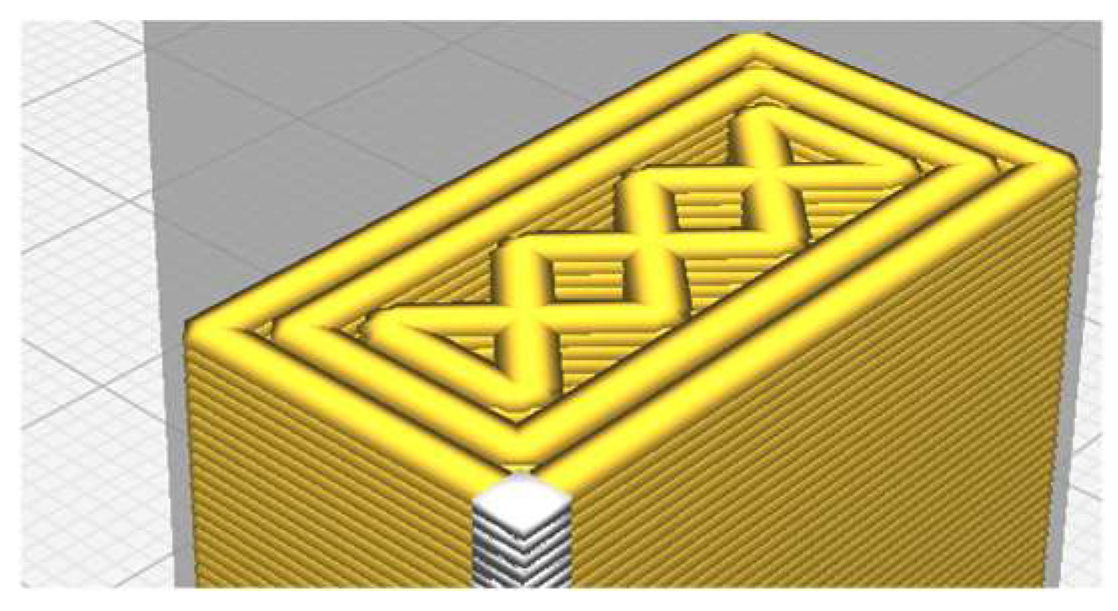
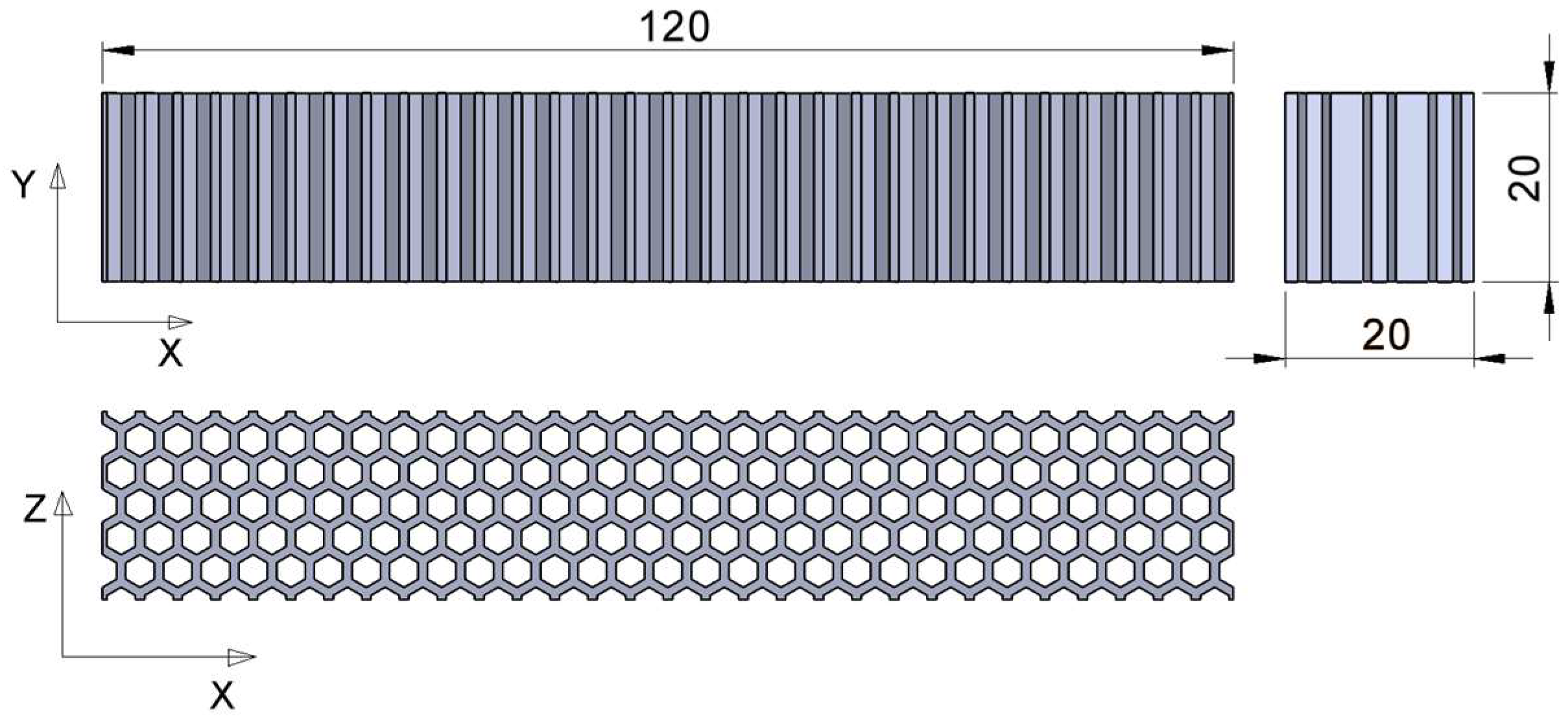



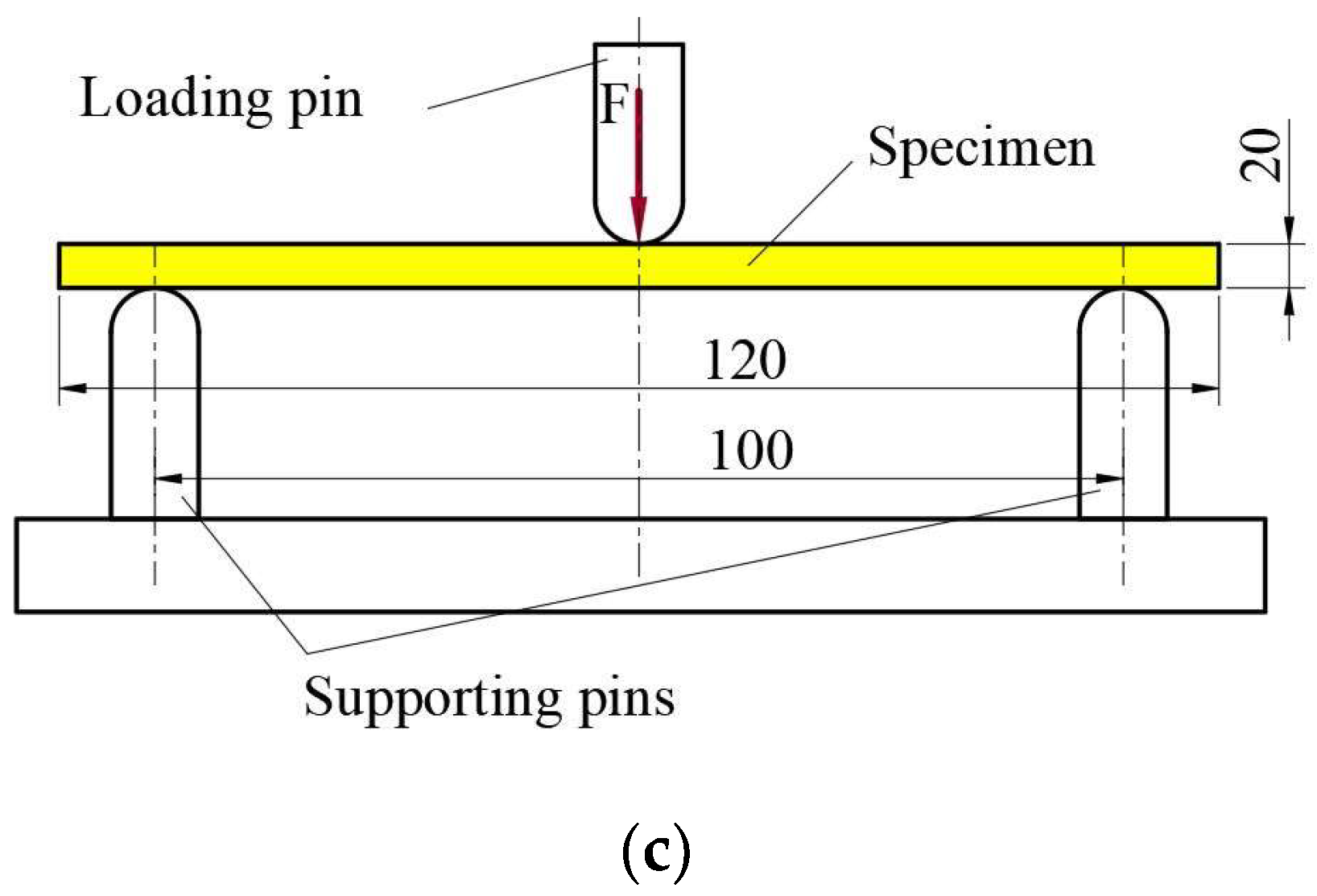


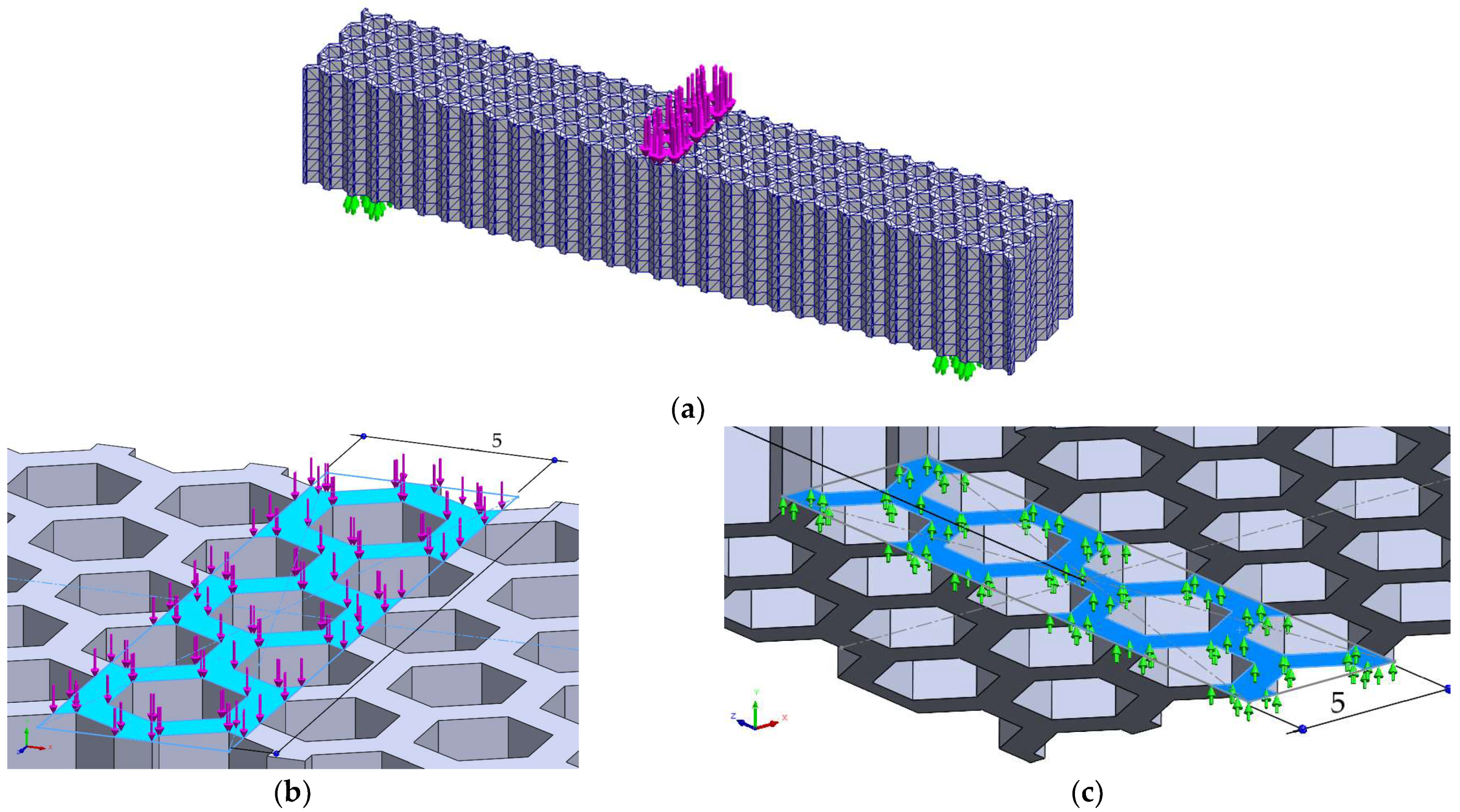



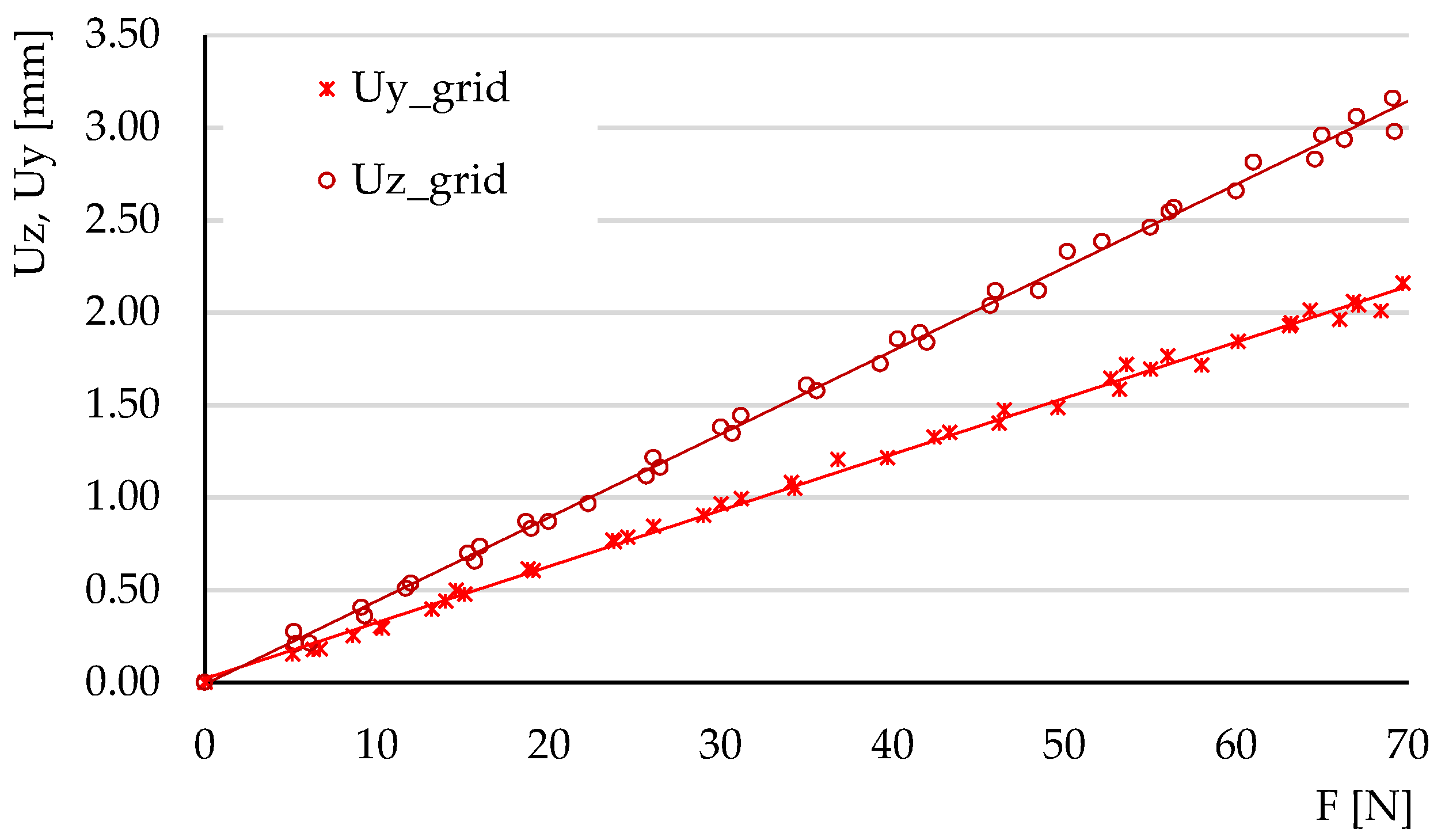
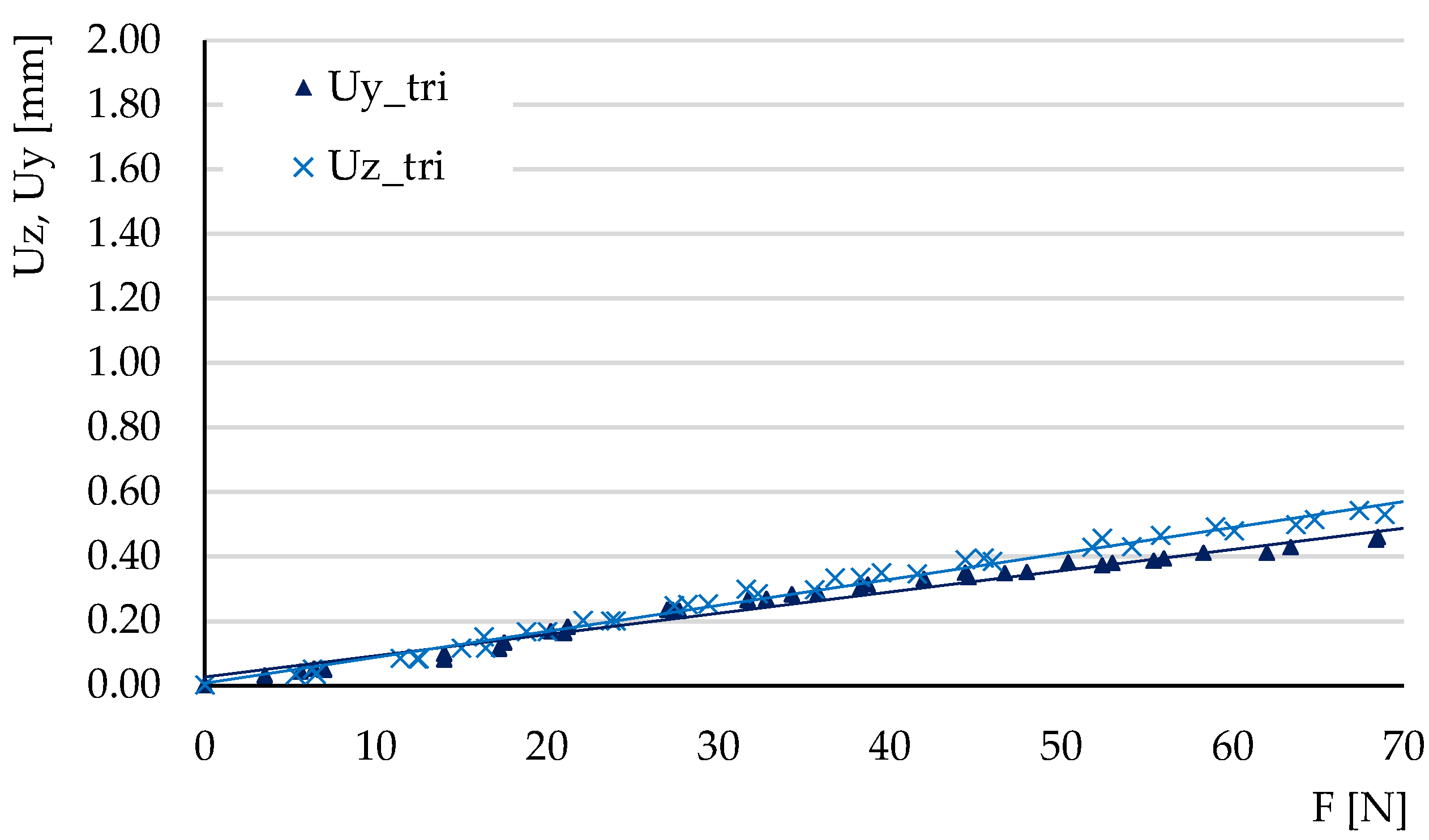
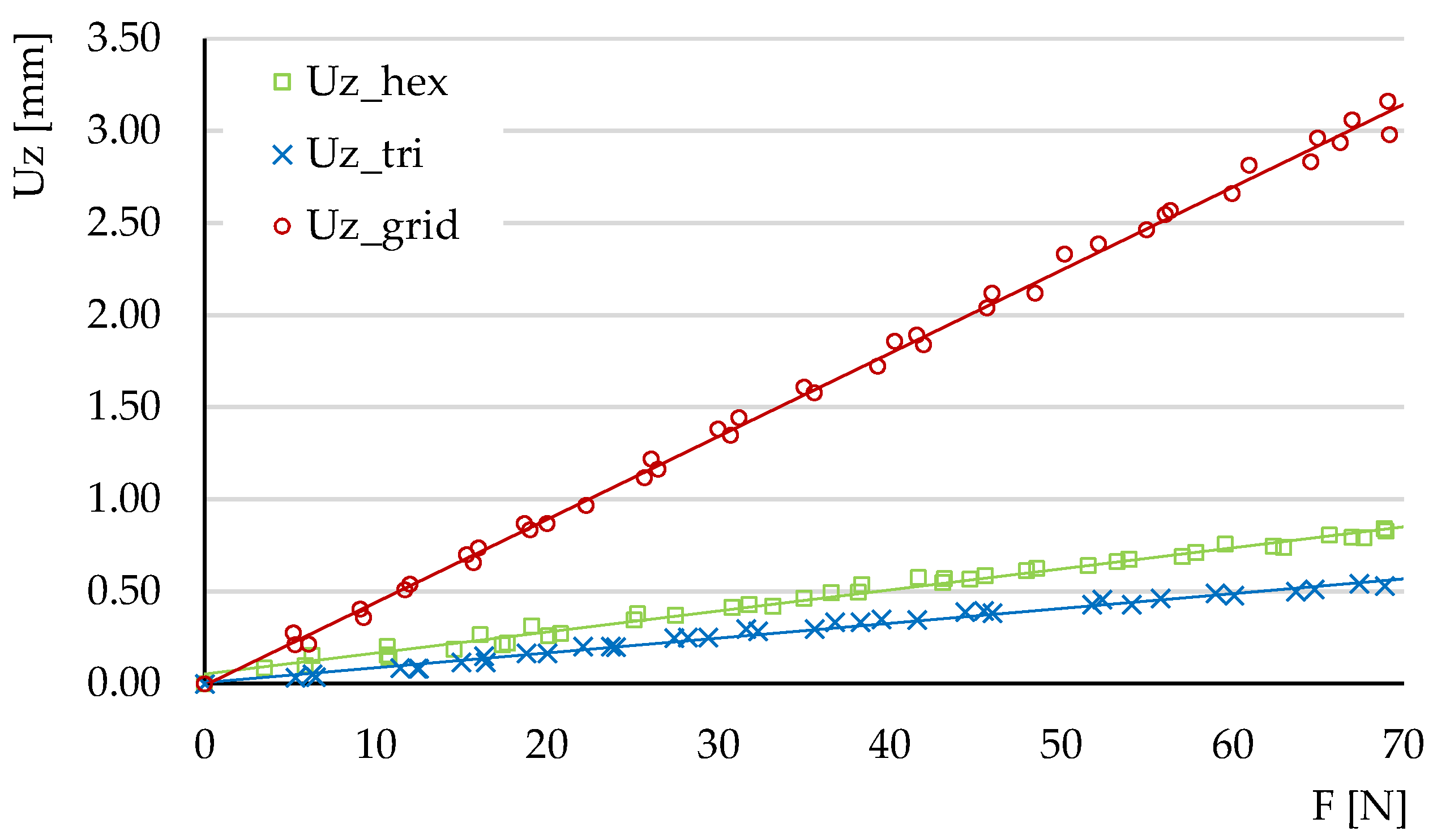
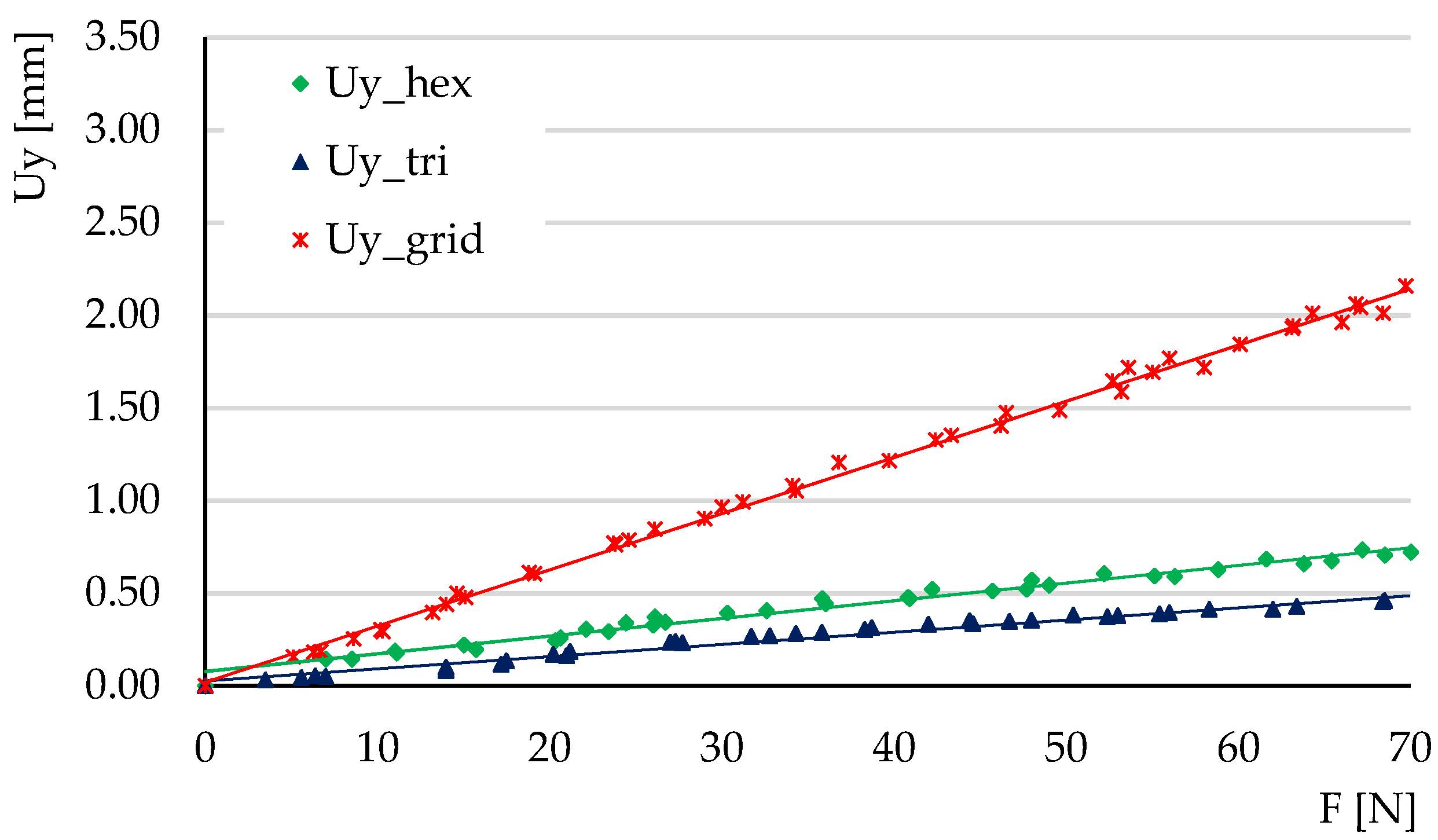


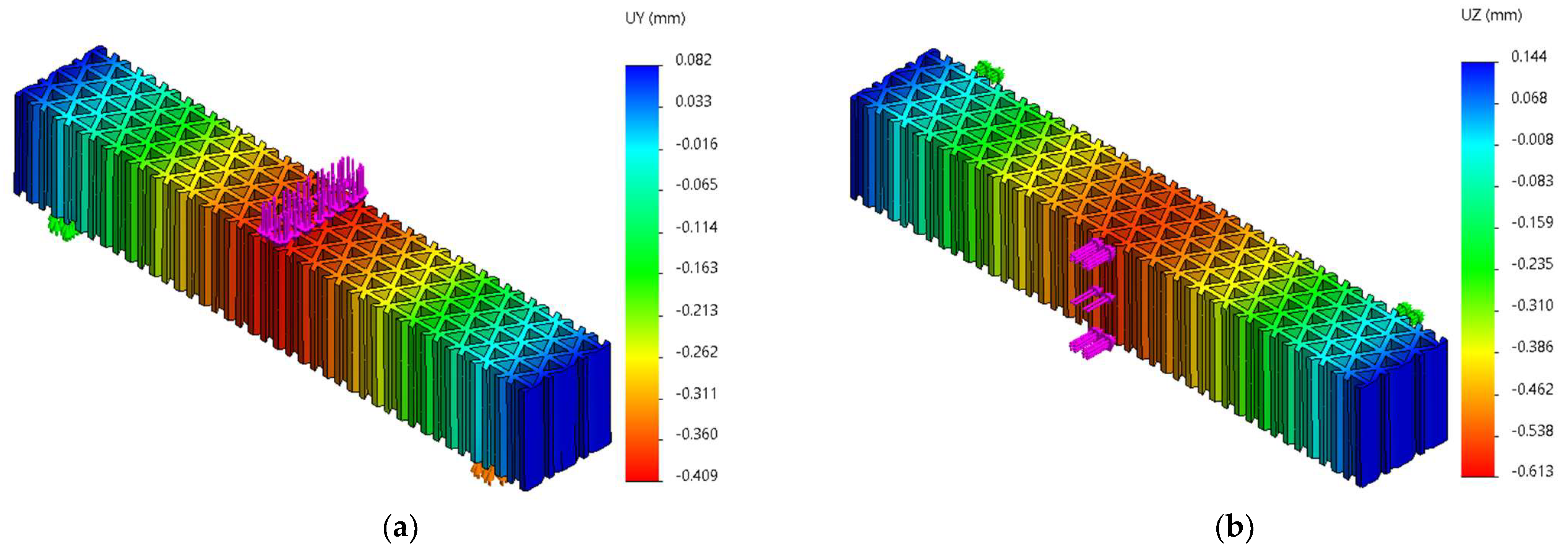
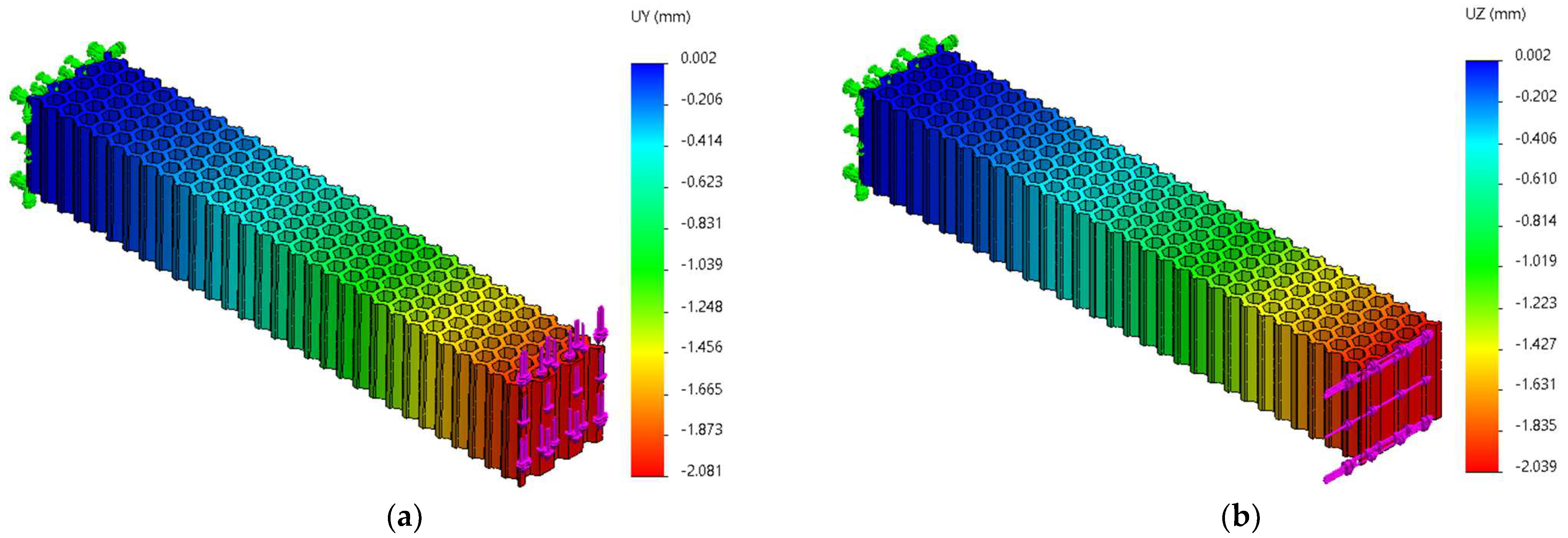
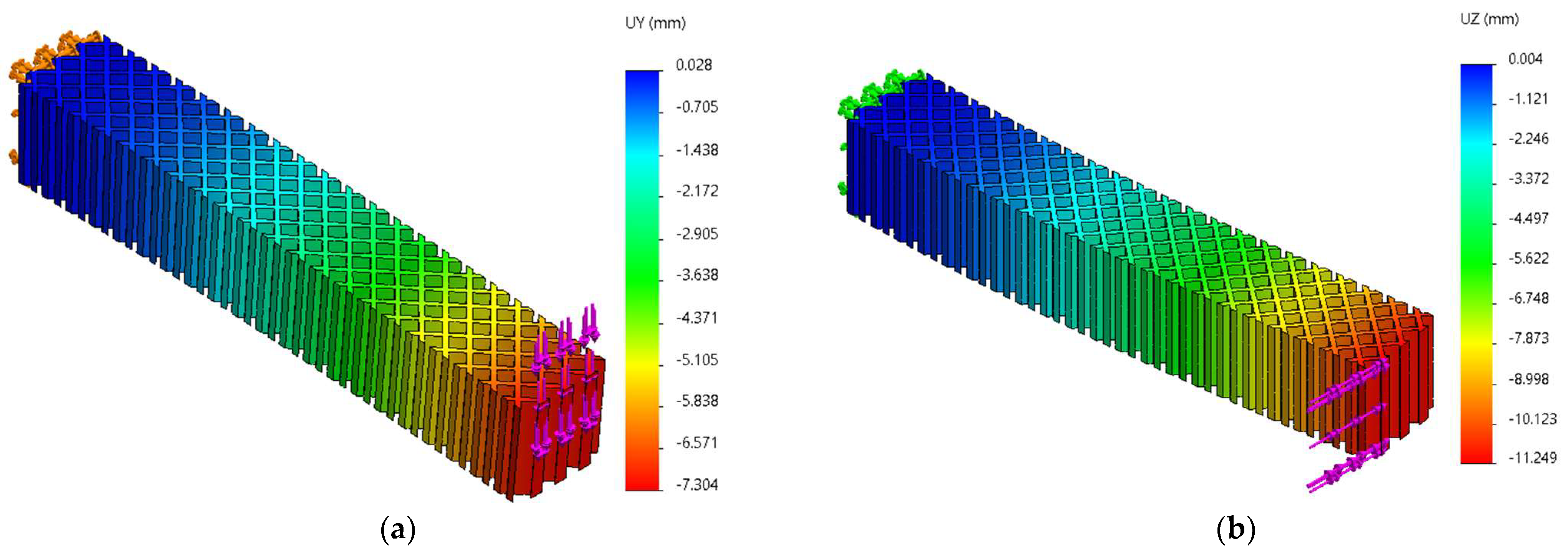
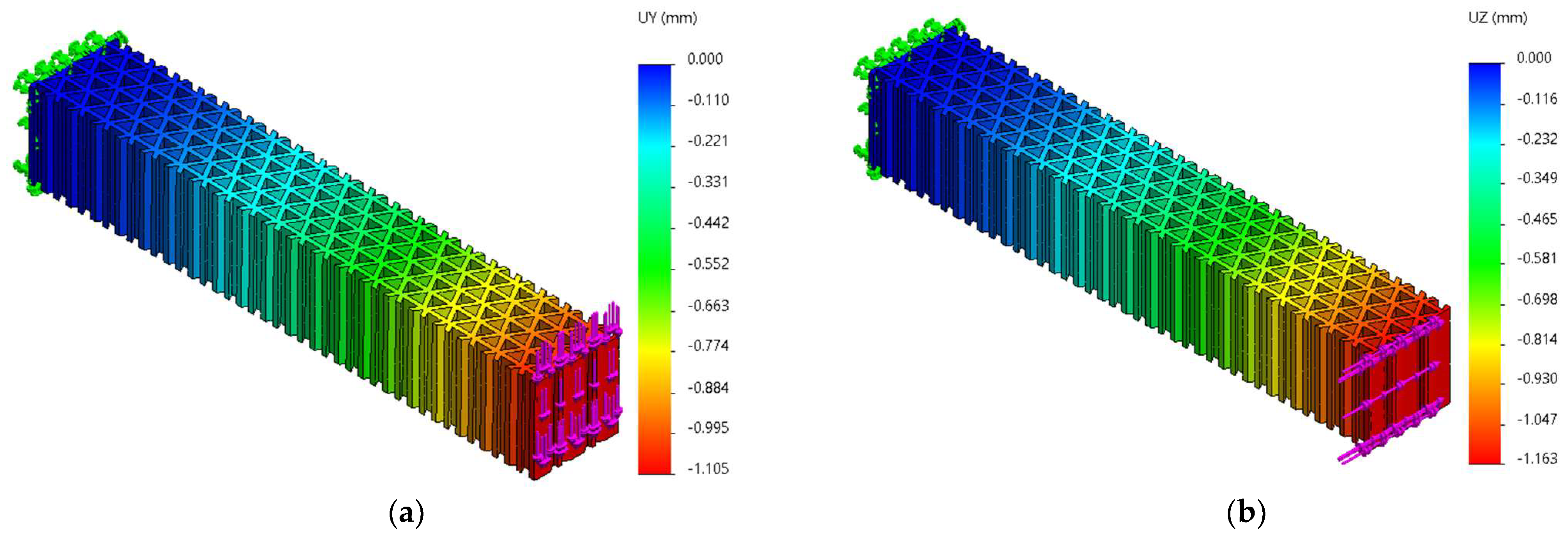

| Sample | Volume [mm3] | Volume Variation rel. to Hexagonal [%] |
|---|---|---|
| Hexagonal | 21,353.07 | 0.00 |
| Grid | 20,964.76 | −1.82 |
| Triangular | 26,468.87 | 23.96 |
| Parameters | Values |
|---|---|
| Process | fused filament fabrication (FFF) |
| Layer thickness, t | 0.1 mm |
| Printing head temperature, TH | 210 °C |
| Build plate temperature, TB | 60 °C |
| Printing speed, sp | 50 mm/s |
| Nozzle diameter, dn | 0.40 mm |
| Filament diameter, df | 2.85 mm |
| Build orientation (acc. to [15]) | XY |
| Material | Ultimaker PLA Silver |
| Geometry | Uy = f(Fy) | Uz = f(Fz) | ||||||
|---|---|---|---|---|---|---|---|---|
| Experimental | FEM | Experimental | FEM | |||||
| R2 | R2 | R2 | R2 | |||||
| Hexagonal | 0.0095 | 0.982 | 0.0095 | 1 | 0.0114 | 0.989 | 0.0113 | 1 |
| Grid | 0.0303 | 0.997 | 0.0183 | 1 | 0.0450 | 0.997 | 0.0478 | 1 |
| Triangular | 0.0066 | 0.975 | 0.0058 | 1 | 0.0080 | 0.987 | 0.0088 | 1 |
Disclaimer/Publisher’s Note: The statements, opinions and data contained in all publications are solely those of the individual author(s) and contributor(s) and not of MDPI and/or the editor(s). MDPI and/or the editor(s) disclaim responsibility for any injury to people or property resulting from any ideas, methods, instructions or products referred to in the content. |
© 2022 by the authors. Licensee MDPI, Basel, Switzerland. This article is an open access article distributed under the terms and conditions of the Creative Commons Attribution (CC BY) license (https://creativecommons.org/licenses/by/4.0/).
Share and Cite
Cojocaru, V.; Frunzaverde, D.; Miclosina, C.-O. On the Behavior of Honeycomb, Grid and Triangular PLA Structures under Symmetric and Asymmetric Bending. Micromachines 2023, 14, 120. https://doi.org/10.3390/mi14010120
Cojocaru V, Frunzaverde D, Miclosina C-O. On the Behavior of Honeycomb, Grid and Triangular PLA Structures under Symmetric and Asymmetric Bending. Micromachines. 2023; 14(1):120. https://doi.org/10.3390/mi14010120
Chicago/Turabian StyleCojocaru, Vasile, Doina Frunzaverde, and Calin-Octavian Miclosina. 2023. "On the Behavior of Honeycomb, Grid and Triangular PLA Structures under Symmetric and Asymmetric Bending" Micromachines 14, no. 1: 120. https://doi.org/10.3390/mi14010120
APA StyleCojocaru, V., Frunzaverde, D., & Miclosina, C.-O. (2023). On the Behavior of Honeycomb, Grid and Triangular PLA Structures under Symmetric and Asymmetric Bending. Micromachines, 14(1), 120. https://doi.org/10.3390/mi14010120








